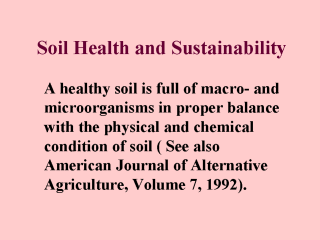 |
Soil forms the thin skin of
unconsolidated mineral and organic matter on the earth’s surface and functions to
maintain the ecosystems on which all life depends. Soil is dynamic, living, natural body
that vital to the function of terrestrial ecosystems and represents a unique balance
between the living and the dead. The perception that soil is «living», though disputed
by some, results from the observation that the number of living organisms in a teaspoon of
fertile soil (10g) can exceed nine billion, one and one-half times the human population of
the earth. Soil form slowly, averaging 100 to 400 years per centimeter of topsoil, through
the interaction of climate, topography, living organisms (microorganisms, animals, plants,
and humans) and mineral parent material over time; thus the soil resource is essentially
nonrenewable in human life spans ( Jenny, 1980; Lal, 1994) (From Advances in Agronomy,
Volume 56, 1996, Copyright ACADEMIC PRESS,INC) |
